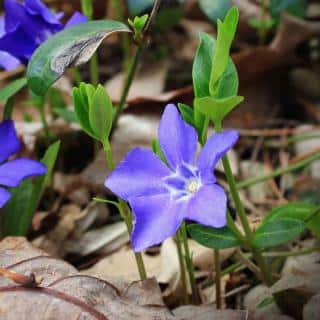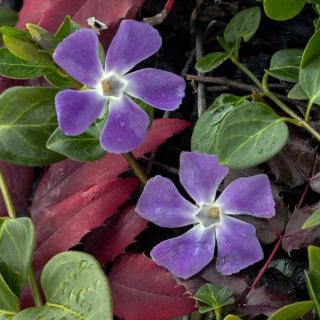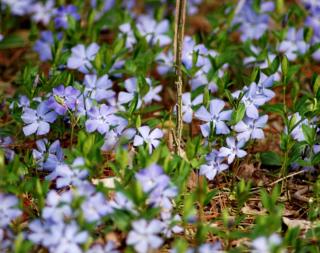

Vinca is a plant genus that’s part of the dogbane family.
Key Vinca facts
Name: Vinca – Common: Periwinkle
Family – Apocynaceae (dogbane)
Type – perennial
Bearing (V. major) – trailing vine
Bearing (V. minor) – ground cover
Height – 1 to 2 feet (30 to 60 cm)
Soil type – any type, moist but draining
Exposure: full sun to full shade – Blooming: spring, sometimes again in fall
Two kinds of Vinca exist, major and minor. This is among the easiest plants to care for, except if your area is prone to drought. In that case, you’ll have to work hard to keep Vinca happy! Both types of Vinca require similar care.
Usually you’ll be purchasing Vinca in a pot, perhaps with flowers already so you’re sure of the variety. It grows in the wild along riverbanks, so best try and reproduce that.
Consistent moisture is needed, so don’t select a dry spot in the garden!
 Dig a hole a bit deeper than the clump.
Dig a hole a bit deeper than the clump.Space plants by 12 inches (30 cm) when preparing a flower bed.
Vinca will do very well in containers and pots, provided that:
Indeed, an unwatered potted vinca will die within a few days. Add hydrogel crystals to the potting soil as a fallback when unable to water.
Seeds often appear after flowers. Certain store-bought varieties are hybrids, their seeds might not set or grow. Nonetheless, if you do get seeds, it’s easy to sow vinca:
If there are many slugs or snails, wait for the plants to have at least 4 pairs of leaves before thinning or transplanting. Protect them well because those fresh leaves are very appealing to them!
After planting, in the ground, water abundantly and immediately. If you have a cover of mulch, it may be enough to water once a week, but if you notice the soil is dry an inch underground near your periwinkle, water right away.
Best practice is to water at ground level or with an irrigation system so leaves don’t get wet. This deters leaf diseases. In dry climates, you might even set up an underground mini-aquifer!
You can let this plant grow freely, it doesn’t need any pruning.

Snipping stems will lead to branching and make your plant more lush and dense.
For a particularly bushy container vinca, snip or pinch stems every 3 leaf pairs as it grows. Do this to each consecutive branch for 3 to 5 weeks early spring, and you’ll have loads of flowers later on!
Vines and stems that bend back to the ground take root and spread from there. It’s similar to the layering of strawberry. This makes the plant invasive in non-native environments since it spreads fast.
Fertilizer leads to vigorous blooming and growth, but vinca still does fine in poor soil. If you do fertilize, only do so two or three times in spring, at one-month intervals.
Water directly at soil level, especially during the summer, or powdery mildew might develop on leaves.
Although vinca is a riverside plant, it’s vulnerable to root rot if soil doesn’t drain well.

Usually, flowers are a range of violet-blue. Interestingly, nurseries are able to offer white or red varieties nowadays.
A shorter growth is what distinguishes Vinca minor. It usually tops out at around 1 foot (30 cm). This is ideal for ground cover, as it will sprawl all over the place without endangering shrubs. An excellent plant to replace lawn grass with.
Apart from size, which is sometimes hard to judge, there is one key difference between the two. Look at leaves: you’ll see edges are different. Both are smooth, but Vinca major has tiny hairs along the edge. Vinca minor doesn’t.
Hard to remember? Here’s a trick: a boy reaching his MAJORity grows hair everywhere, whereas a MINOR doesn’t!
A plant similar to Vinca is Madagascar Periwinkle (Catharanthus roseus). It used to be called Vinca roseus because botanists thought it was the same plant! Madagascar periwinkle is the tallest of the three, and is also more drought-resistant. It isn’t related to the two Vinca plants and cross-pollinizing them won’t bear fruit.
Another vinca look-alike is the Impatiens family, especially the Sunpatiens flower. The main difference is in the leaves: impatiens leaves are jagged with small teeth, whereas Vinca leaves are smooth and continuous.
Vinca is among the first flowers to bloom in spring, right after early bulbs. Native to Europe, this plant is naturalized in the Americas. Gardeners rate it with a high ornamental value. It was actually brought to the United States around the 1700s, in part for its beauty, and in part for its medicinal value.
In some areas that most resemble Vinca‘s native habitat, such as along riverbanks, it tends to crowd other plants out. This is why the plant is invasive in states like California (V. major), and many Eastern states (V. minor) such as Kentucky, Tennessee, Georgia, South Carolina, Virginia and Pennsylvania.
Use the long, twining vines to weave wreaths of flowers for children!